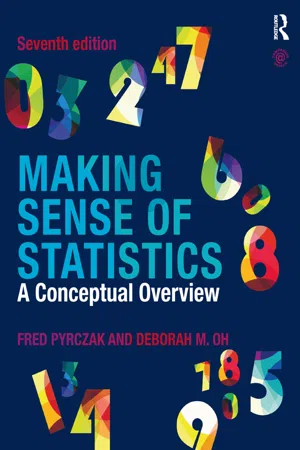
- 240 pages
- English
- ePUB (mobile friendly)
- Available on iOS & Android
About this book
Making Sense of Statistics is the ideal introduction to the concepts of descriptive and inferential statistics for students undertaking their first research project. It presents each statistical concept in a series of short steps, then uses worked examples and exercises to enable students to apply their own learning.
It focuses on presenting the why as well as the how of statistical concepts, rather than computations and formulae, so is suitable for students from all disciplines regardless of mathematical background. Only statistical techniques that are almost universally included in introductory statistics courses, and widely reported in journals, have been included. Once students understand and feel comfortable with the statistics that meet these criteria, they should find it easy to master additional statistical concepts.
New to the Seventh Edition
Retaining the key features and organization that have made this book an indispensable text for teaching and learning the basic concepts of statistical analysis, this new edition features:
- discussion of the use of observation in quantitative and qualitative research
-
- the inclusion of introductions to the book, and each Part.
-
- section objectives listed at the beginning of each section to guide the reader.
-
- new material on key topics such as z-scores, probability, Central Limit Theorem, Standard Deviation and simple and multiple regression
-
- Expanded discussion on t test with separate sections for independent and dependent samples t tests, as well as one-sample t test
-
- progressive analysis of bivariate vs multivariate statistics (starts with the basic concepts and moves to more complex analysis as the student progresses)
-
- updated and extended pedagogical material such as Chapter Objectives, exercises and worked examples to test and enhance student's understanding of the material presented in the chapter
-
- Bolded key terms, with definitions and Glossary for quick referral
-
- expanded Appendices include a brief reference list of some common computational formulas and examples.
-
- a Glossary of key terms has been added at the end of the book, with references to sections in parenthesis.
-
- New online instructor resources for classroom use consisting of test bank questions and Powerpoint slides, plus material on basic math review
Frequently asked questions
- Essential is ideal for learners and professionals who enjoy exploring a wide range of subjects. Access the Essential Library with 800,000+ trusted titles and best-sellers across business, personal growth, and the humanities. Includes unlimited reading time and Standard Read Aloud voice.
- Complete: Perfect for advanced learners and researchers needing full, unrestricted access. Unlock 1.4M+ books across hundreds of subjects, including academic and specialized titles. The Complete Plan also includes advanced features like Premium Read Aloud and Research Assistant.
Please note we cannot support devices running on iOS 13 and Android 7 or earlier. Learn more about using the app.
Information
PART F
Means Comparison
CHAPTER 21
Introduction to the t Test
Chapter Objectives
Example 1
Table of contents
- Cover
- Half Title
- Title Page
- Copyright Page
- Table of Contents
- Introduction to the Seventh Edition
- Acknowledgments
- Introduction: What is Research?
- Part A: The Research Context
- Part B: Sampling
- Part C: Descriptive Statistics
- Part D: Correlational Statistics
- Part E: Inferential Statistics
- Part F: Means Comparison
- Part G: Predictive Significance
- Appendix A: Computations of the Standard Deviation
- Appendix B: Notes on Interpreting Pearson r and Linear Regression
- Appendix C: Table of Random Numbers
- Appendix D: More about the Null Hypothesis
- Comprehensive Review Questions
- Glossary
- Index